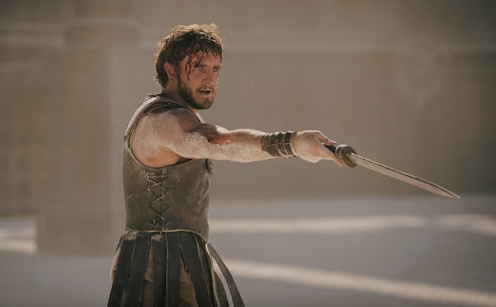
Paul Mescal as Lucius in ‘Gladiator II.’ Paramount
Neither “Gladiator” nor its cinematic sequel is particularly concerned with historical fact. For one thing, the emperor Marcus Aurelius had no intention of restoring the republic. Gladiatorial contests were abhorrent displays of cruelty, but they didn’t always end in death. And the Romans didn’t sculpt bone-white statues; they painted them using an array of colors.
But I’m most interested in how the two films misrepresent the way Roman gladiators and their bodies were viewed by their republic-minded contemporaries.
In the films, the brawny biceps of gladiators Maximus and Lucius reflect “strength and honor” – to reprise the motto of the franchise – as each of these heroes fights to overthrow self-indulgent emperors and to restore the Roman republic with its traditional political values of liberty and self-restraint.
However, as I discuss in my book, “Vitruvian Man: Rome Under Construction,” the gladiator represented something else altogether. The most famous martyr of the Roman republic – Marcus Tullius Cicero – used gladiators’ physiques not to celebrate the republic’s valiant heroes, but to deride their bloated muscles as the embodiment of amoral tyranny.
Enemies of the Republic?
Cicero’s career was both marked and made by the constitutional crises that characterized the last decades of the Roman republic. In several of his speeches from the period, he characterized the enemies of the republic as gladiators.
In the so-called second Catilinarian conspiracy of 62 B.C.E., Lucius Sergius Catilina, also known as Catiline, attempted a coup after losing his campaign to become a consul. Rome’s highest office, a consul was the rough equivalent to a U.S. president, except he served for one year alongside another consul, with each wielding equal political power.
Cicero saw little to admire in a brawny body.
Stock Montage/Getty Images
Cicero, who was consul himself that year, pulled no punches in his speeches, which were all premised upon the notion that the would-be usurper Catiline – though of noble birth – was an enemy because he associated with “the criminals of the gladiatorial schools.”
The real defenders of Roman values – according to Cicero, anyway – exchanged sharp words in the Roman senate. Catiline, on the other hand, “trained” his superhuman physical hardiness to inflict “insult” and “wickedness” on the republic, its institutions and its freedoms, all while wielding a dagger, the weapon of thugs and cutthroats.
A couple of decades later, when the Roman republic had placed unprecedented political power in the hands of three men, Cicero again deployed the figure of the gladiator as a troubling symbol.
This time, he used it to call out one of these three “triumvirs,” Mark Antony, whose later alliance and dalliance with Cleopatra made him an enemy not only of the Roman republic, but also of Roman identity itself.
In his red-hot second Philippic – one of 14 invectives directed against Antony – Cicero put the spotlight on Antony’s rugged, gladiatorial body and its monstrous capacity for self-indulgence. This was a disgrace unfit for the Roman populace, and it was at odds with the traditional value of self-restraint in Roman political life:
“You! With your neck, your sides, your hard, gladiator’s body: you drained down enough wine at Hippia’s wedding that you had to throw it all up in plain sight of the Roman people the next day.”
But apart from the simple fact that most gladiators were enslaved – and, for that reason, were scorned by elites as social outcasts – there is another reason for the prevalence of this image in Roman political language.
Caricature as character
To participate in Roman political culture required training in rhetoric and oratory.
Although a good deal of oratorical training was done by modeling oneself after one’s teachers, the first century B.C.E. saw an influx of influential rhetorical teachers from Greece, and a boom in what might loosely be called textbooks of rhetoric. These manuals not only offer theoretical discussions of what makes a good speech, but they also reveal a great deal about Roman values.
Books like the anonymous “Rhetoric for Herennius,” which circulated in the earlier years of Cicero’s political career, teemed with examples for how to characterize the opposition in a court of law.
The author – as Cicero wrote in his own work, “On Rhetorical Brianstorming” – emphasized that discussions of physical attributes were not just fair game; they were all but expected as a way to highlight a plaintiff’s or defendant’s virtuous – or vicious – character.
Good looks, for instance, could be used favorably to show how nature’s blessings added to a client’s virtue without leading to pride. When characterized unfavorably, those same good looks might be spun as a product of the opponent’s vanity and self-indulgence.
More to the sword-point: According to the author of “Rhetoric for Herennius,” qualities of speed and strength might be highlighted to show “respectable training and effort” when done in moderation. But if you’re looking to tear down an opponent, the orator may “mention his use of [speed and strength], which any given gladiator may have thanks to dumb luck.”
Strength? Definitely.
Honor? Depends who you ask.
John M. Oksanish does not work for, consult, own shares in or receive funding from any company or organization that would benefit from this article, and has disclosed no relevant affiliations beyond their academic appointment.
Advertisement

Advertisement
Contact Us
If you would like to place dofollow backlinks in our website or paid content reach out to info@qhubonews.com











